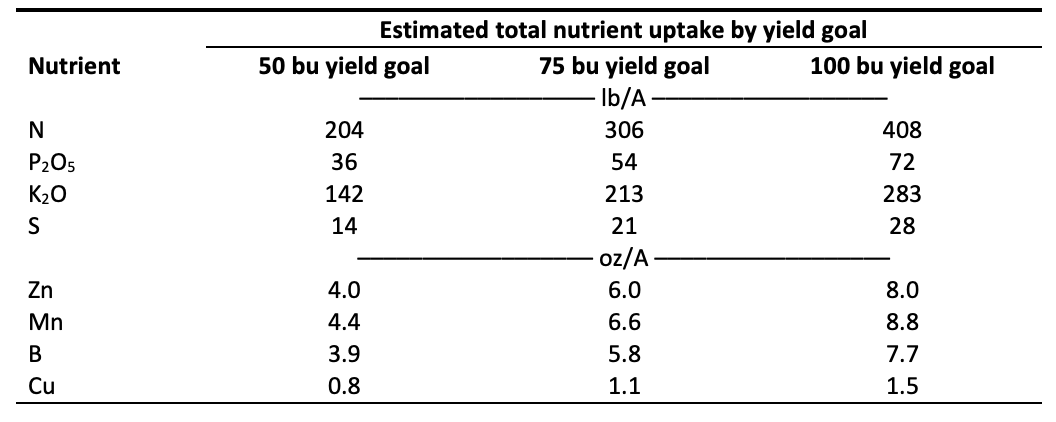Planting season has begun and with it comes the anticipation of in-season crop management decisions. Optimizing fertility management is one of the cornerstones of a high yielding soybean crop. The knowledge of how much nutrition a soybean plant requires, the timing of when it is taken up, and how the plant distributes nutrients internally are a few of the details that contribute to effective pre-season and in-season crop fertility management planning.
A soybean crop is no different than an elite athlete. Before you dismiss this as nonsense, let me explain. High yielding crops and athletes both require balanced nutrition and energy to succeed, and for plants, these inputs are provided neither by a protein shake, nor a salad, but by way of nutrients taken up from the soil and carbon harnessed through the energy of the sun. A soybean crop and an athlete both have goals for how much nutrition they require for an expected level of performance, but does the timing of when these meals are eaten matter? Absolutely. Just like an NFL football player would not eat just one meal before the season starts, a high yielding crop needs to continue to eat ‘meals’ at just the right times to optimize its performance. For a soybean crop, or any other type of crop for that matter, we can optimize fertility management through understanding how much nutrition is required (soil test values and fertilizer rates), when this nutrition is needed (timing of application or availability), and how the plant distributes a particular nutrient between stem, leaf, and pods.
Amount of crop nutrient uptake
Soybean nutrient uptake (think pounds or ounces per acre) quantifies the amounts of essential macro- and micronutrients in the above ground parts of the plant (leaves, stems, and pods). Total crop nutrient uptake is influenced by nutrient availability in the soil and demand for nutrients by the growing crop. A healthy, high yield potential crop growing in fertile soil will take up more total nutrients than a low yield potential crop or one growing in soils with one or more nutrient deficiencies. Nutrient uptake should not be confused with nutrient removal. Nutrient removal is a portion of total uptake, but it is used to describe the amounts of nutrients that are removed with the harvested grain and helps to inform maintenance fertilizer application decisions. Although we do not need to supply the entire amount required for uptake through fertilizer applications, knowing these values does help in designing fertility plans to target a specific yield goal:

Adapted from: Modern Soybean Varieties’ Nutrient Uptake Patterns (Bender, Haegele, and Below, 2015, Better Crops Vol. 99).
Timing of crop nutrient uptake
Crops vary in when they take up certain nutrients. This timing is influenced by the growth habit of a crop and its phenology. For example, a corn crop tends to take up a greater proportion of nitrogen (N) and potassium (K) prior to tasseling, whereas nutrients like phosphorus (P) and zinc (Zn) are more evenly distributed in their pre- and post-flowering uptake. For indeterminate soybeans, the progression of nutrient uptake is more consistent across the course of the growing season for most nutrients. One exception is potassium; approximately 75 percent of total K uptake occurs before pod filling begins. The period of most rapid nutrient uptake (pounds or ounces per acre per day) occurs during the days bracketing the R4 (full pod set) growth stage. This is one reason why foliar applications of micronutrients or supplemental applications of macronutrients are important considerations with an R3 to R4 fungicide and insecticide application.
Distribution and physiological significance of nutrients
The total amount, the distribution of a nutrient within the plant, and what the nutrient does in the plant can influence the most appropriate application method for individual nutrients. For example, macronutrients that are required in larger amounts (e.g., P and K) are best supplied in forms that can be taken up by the roots over a longer period. In the case of micronutrients like Zn and manganese (Mn), which are required in small amounts and are mostly involved in supporting photosynthetic activity in the leaves, foliar applications can be effective to target the nutrients to the part of the plant where they are needed most.
Recommendation
Managing for high yield soybean has many facets but understanding the nutritional requirements and building a plan to meet these needs are table stakes for raising a bumper crop. For some, the first step may be simply supplying greater amounts of P and K based on a soil test. For others who have already built a foundation of reliable soil fertility, implementing more sophisticated in-season management approaches using multiple foliar applications could be the next step. Regardless of where you are at in your soybean management journey, take the time now to plan for a successful 2021 crop.




 and then
and then